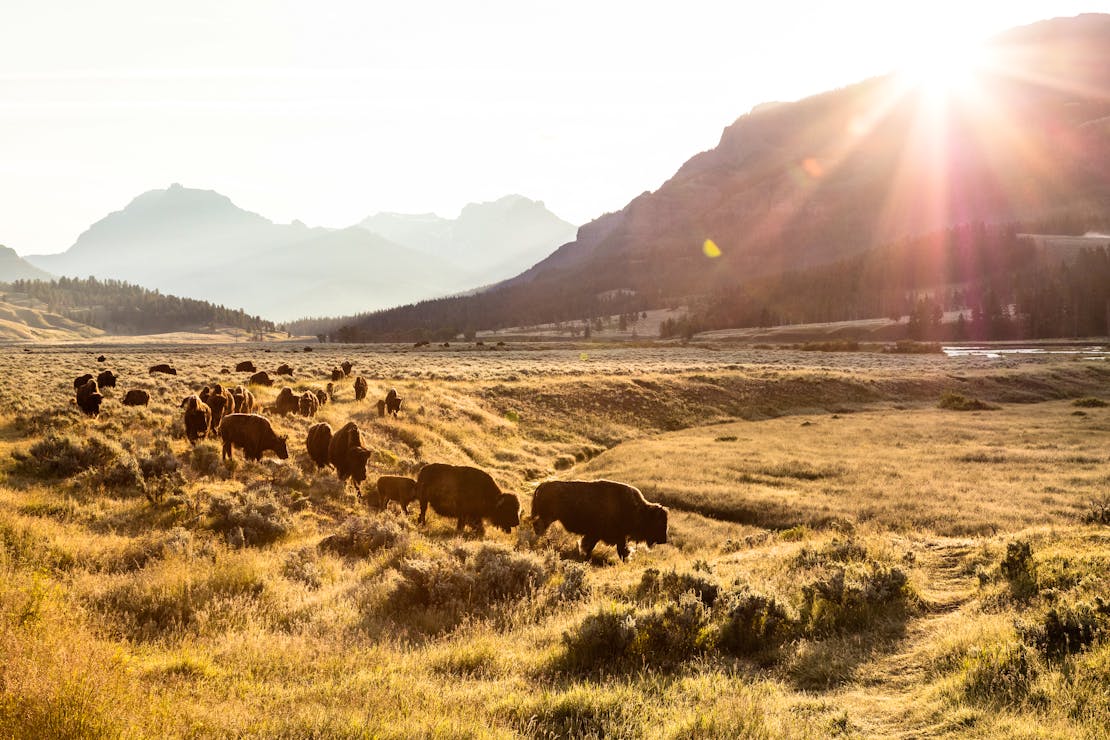In Yellowstone National Park, the American bison, a species considered ecologically extinct, is making a comeback and providing dividends to the park’s grasslands, visitors and to Indigenous communities and their lands. Plains bison inhabiting the park today are part of a cooperative program giving tribes nationwide the opportunity to once again live in harmony with their “buffalo.” A new plan finalized by the park over the summer means more bison will be allowed to utilize not only the park’s habitat, but also tolerance areas outside its boundaries dedicated nearly a decade ago by the state.
The best part is how members and supporters of Defenders of Wildlife played a key role in making this new plan happen.
The “Record of Decision” for Yellowstone’s Bison Management Plan allows for the park to manage an increased population range of between 3,500 and 6,000 bison after calving. Those bison can also now roam year-round into the adjacent Custer Gallatin National Forest, where they can be hunted by tribes and the public.
Hunting is a key “removal tool” noted in the plan for keeping the population in line with the available habitat both within and outside the park. The other listed tool is the ability for the park to test bison for brucellosis to then be eligible for the Bison Conservation Transfer program, shipping animals free of brucellosis and other disease, valued for their high genetics to tribes across the country. To date, 26 tribes in 12 states have received Yellowstone bison to start or add to their cultural herds. Thanks to the new plan, those numbers will only grow.
Want and Need
Yellowstone’s new bison plan isn’t exactly what some conservation groups had asked for. Defenders and its partners in the Montana Bison Working Group had made a science-backed push for a higher population target. The final plan is the result of Defenders’ advocacy along with that of our members, who submitted thousands of comments supporting the increased population, as well as enhanced co-stewardship with the tribes of Yellowstone. The final plan’s population range is a compromise providing the park with the flexibility and tools to manage herds by addressing conflicts, such as when high snow levels cause large numbers of bison to move into the Gardiner Basin; and giving the cooperating partners some assurance of the plan’s adaptive measures.
Yellowstone’s plan is actually one of three options agreed to by Montana after the state disagreed with an initial plan released in 2022. Yellowstone National Park went to considerable lengths to include input from the Forest Service, Montana, USDA-APHIS and the tribes. The park also received more than 20,000 public comments in total.
The final Yellowstone plan is the first of its kind to include the needs of tribes with long ancestral ties to the Greater Yellowstone Area and to the Plains bison that are vital to Indigenous communities. The Forest Service and Montana also need to follow through on their responsibilities under the plan by cooperatively managing the bison and providing for greater, enhanced use of dedicated habitat outside of Yellowstone, including migration routes and calving areas. Management under the plan is also adaptive, allowing for the park to assess habitat conditions while ensuring herd dynamics for the health of the population. That can lead to the expansion of the Bison Conservation Transfer Program, allowing tribes across the country to return Plains buffalo to their lands.
Another great assurance is the plan’s readiness to face change. Humans can draw plenty of lines around population limits, but bison will roam, and weather will shift. There’s no way to guarantee, for example, how many bison will actually migrate out of the park and into the tolerance areas – where hunting is allowed and a year-round herd is now possible, nor how many will end up going to tribes through the transfer program.
Now that the Yellowstone Bison Management Plan has been made official, many lights have simultaneously turned green. Yellowstone has the green light to allow bison access to the 2015 tolerance areas, boosted by Custer Gallatin’s new forest plan, which provides for specific habitat restoration projects designed to encourage bison movement. The western side of the park gets a green light, as conflicts with ranchers and private landowners have been addressed over the years, with help from the Defenders-supported fencing program designed to keep bison off private properties. The Bison Transfer Program has the green light to grow in new ways by increasing capacity and transferring more bison to tribes. There’s also a green light for Defenders to expand its role with the transfer program by supporting the partners with facility upgrades and new transport trailers, making the transfers smoother for the bison.
Every one of those green lights means the park and the partners can do more for the bison of Yellowstone. That’s thanks not only to all who advocated for the plan, and to the park for creating measures for contemporary management, but thanks to the supporters who spoke up to make sure that the American bison got what it needs to turn around the moniker of “ecological extinction” and thrive in its homeland on the plains once again.











Follow Defenders of Wildlife
facebook bluesky twitter instagram youtube tiktok threads linkedin